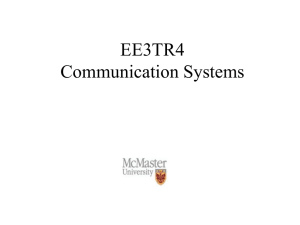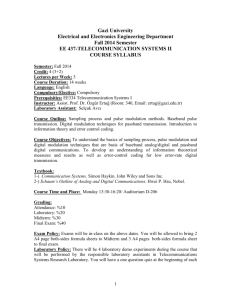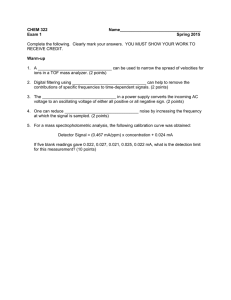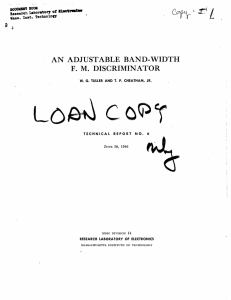IV AND UTILIZATION EATED
advertisement
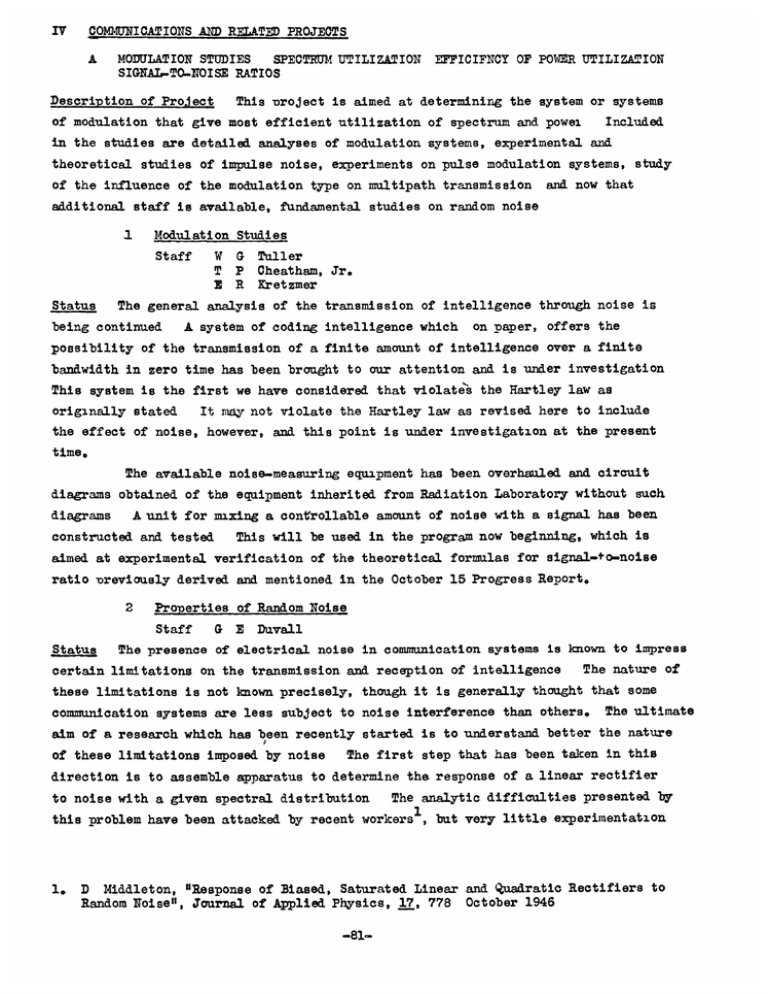
IV COMMUNICATIONS AND REATED PROJECTS 1 A MODULATION STUDIES SPECTRUM UTILIZATION SIGNAL-TO-ITOISE RATIOS EFFICIFNCY OF POWER UTILIZATION This nroject is aimed at determining the system or systems Description of Project of modulation that give most efficient utilization of spectrum and powex Included in the studies are detailed analyses of modulation systems, experimental and theoretical studies of impulse noise, experiments on pulse modulation systems, study of the influence of the modulation type on multipath transmission and now that additional staff is available, fundamental studies on random noise Modulation Studies 1 Staff Status W T E G P R Tuller Cheatham, Jr. Kretzmer The general analysis of the transmission of intelligence through noise is being continued A system of coding intelligence which on paper, offers the possibility of the transmission of a finite amount of intelligence over a finite bandwidth in zero time has been brought to our attention and is under investigation This system is the first we have considered that violate's the Hartley law as originally stated It nmay not violate the Hartley law as revised here to include the effect of noise, however, and this point is under investigation at the present time. The available noise-measuring equipment has been overhauled and circuit diagrams obtained of the equipment inherited from Radiation Laboratory without such A unit for mixing a controllable amount of noise with a signal has been diagrams constructed and tested This will be used in the program now beginning, which is aimed at experimental verification of the theoretical formulas for signal-o-noise ratio ureviously derived and mentioned in the October 15 Progress Report. 2 Properties of Random Noise Staff Status G E Duvall The presence of electrical noise in communication systems is known to impress certain limitations on the transmission and reception of intelligence The nature of these limitations is not known precisely, though it is generally thought that some communication systems are less subject to noise interference than others. The ultimate aim of a research which has been recently started is to understand better the nature of these limitations imposed by noise The first step that has been taken in this direction is to assemble apparatus to determine the response of a linear rectifier to noise with a given spectral distribution The analytic difficulties presented by this problem have been attacked by recent workers , but very little experimentation 1. D Middleton, "Response of Biased, Saturated Linear and quadratic Rectifiers to Random Noise", Journal of Applied Physics, 17, 778 October 1946 -81- has been c~rried out Furthermore, the analysis involves approximations which prevent it from distinguishing between certain spectral cnaracteristics, which may or may not be importan In view of these conditions it has seemed -xpedient to begin an investigation of detec*ors by obtaining some experimental data wich will be useful in checking calculations that have been made and may also help in construcaing other and simpler approximations Two techniques can be used to measure tne snectrum of the output of a linear rectifier One is to construct a linear rectifier and measure the output with a suitable spectrum analyzer The other is to photograph the input to the rectifier and measure the coherence of the envelope of the noise by means of a quantity called tne "correlation function" From this correlation function the spectrum of the envelope is obtained by a transformation The snectrum of the envelope is then the spectrum of the low- frequency response of an ideal linear rectifier (except for the d-c component) The present state of the research is that nrelimipary photographs of the type described above have been obtained and show rather interesting characteristics. Before a detailed analysis is undertaken, however aoparatus of a more permanent nature will be assembled to insure stability of electrical characteristics 3 Impulse Noise in Frequency Modulation Staff 'W G Tuller T P Cheatham, Jr Status An analysis of the transient resporse of the conventional Foster-Seeley type discriminator has been completed The analysis has been attempted in detail N for an input to the discriminator of a square-wave modulated carrier L= u(t) sin ptj and for a transient impulse originating as a result of a d-c pulse of short time duration injected into the receiver filter Expressions have been derived for both the envelope of the resulting transient and the instantaneous phase of the resultant signal vector for the case of the square-wave modulated carrier input From the expression for the instantaneous phase an expression for the fractional deviation of the instantaneous frequency of the resultant transient signal vector from the steady-state frequency carrier vector also has been set up according to the method outlined on pages 247-253, of Gardner and Barnes "Transients in Linear Systems" In view of the observed importance of having a carefully balanced detector in the output of the Foster-Seeley discriminator a variable air dielectric condenser has been used in place of one of the fixed capacitors in the R-0 detector output circuit With this change in the experimental circuit, it has been possible to check and verify the general conclusions indicated by the above analysis, namely that the transient response of a Foster-Seeley discriminator to a square-wave modulated carrier and to a transient impulse originating as a result of impulse noise in the receiver filter should be nearly zero within certain limits of alignment and adjustment of the receiver In fact an extension of the same line of reaqoning indicates that this statement may be made regarding any periodic wave providing the -82- carrier frequency is the same as the center frequency of the discriminator A technical report covering this analysis is now being prepared A simultaneous mathematic1 and experimental check is being made of the Bradley and Smith of the Philco Research Laboratories material presented by Messrs in their paper on "The Theory of Impulse hoise in Iaes, Wrequency-modulation Receivers" 1 Our initial results verify the conclusions of this paper in general, but disagree with some of the detailed conclusions This work will also be pre- sented in the technical report mentioned above 4 Pulse Modulation Studies Staff W G Tuller 3 R Kretzmer The ten-channel pulse-position modulation receiver, mentioned in the Status October 15 Progress Report, is being analyzed and modified for optimum operation The following chief components have been analyzed and redesigned where necessary A limiter using high back-voltage crystals devised for use in a has been mentioned in the video stages the previous report A coincidence circuit which is b intended to pass only a triple- coded synchroIniZing pulse has been experimentally adjusted for optimum performance It was found thatta compromise must be made between perfection in discriminating ability on the one hand, and stability and amplitude of the output on the other hand A reactance tube, and th 10-kc oscillator which it controls, have c been incorporated in a single 6SL7 twin triode The oscillator, which establishes is to be locked to the synchronizing pulses by the time reference for the receiver an automatic phase and frequency control system Considerable time has been spent in developing the automatic d control system mentioned in (c) above This system consists of the reactance-tube- oscillator unit plus a "pick-off" which forms low-jitter pulses from the oscillator output, and a pulse-phase discriminator which produces a direct voltage proportional to the phase difference between the synchronizing and local-oscillator pulses Besides the experimental work a complete theoretical study of the system is also under way. The problem is to obtain the desired stability, with reliable locking-in over a range of a few hundred cycles of the synchronizing frequency The development of the system has not as yet been completed As for theoretical work pulse modulation have been compiled pulse-amplitude 1 In each type of pulse modulation, such as pulse-width, and pulse-position modulation, the modulation can be applied in various ways cases certain facts concerning the various kinds of and while the differences may seem small, they are, in some of importance Proc IRE, 34 743 (1946) -83- Multipath Transmission 5 Staff Status Professor L J Granlund B Arguimbau As mentioned in the last Progress Report trouble was experienced with incidental modulation in the "amplitude-modulated" signal generator and in getting proper preemphasis from the frequency-modulated generator have been overcome These difficulties Preliminary studies have beenimade with both amplitude- and frequency-modulated signals In the case of amplitude-modulated signals a variation in the length of the second path has been found much more serious than a variation in its numerical transmission numerical ratio between the two signals is With frequency-modulated signals the the only important factor There is still a small amount of uncertainty about the routine action of the receiver and other standard circuit components, but it is expected that a final report on the project can be submitted in about three months IV B. STABILIZED OSCILLATORS Staff W F C Galloway P Description of Project Zaffarano A general investigation has been undertaken of the stable microwave sources so vitally needed in communications systems and as a research tool in both physics and electrical engineering Emphasis is being placed on the improvement of performance, which, it is hoped, will eventually lead to the improvement of modulating techniques. Status One of the principal difficulties entering into the wide-band operation of a Pound1 discriminator can be traced to the difference in the length of the path traversed by the energy going into sidebands as compared to the energy entering directly into the detector crystal as a careier By a slightly more complicated arrangement of components than used by Pound, it has been found feasible to equalize the two path lengths so that the band over which such a discriminator may operate without adjustment is limited principally by the bandwidth of the magic T and the crystal terminations. Although an imoroved frequency range is the main objective of the new discriminator configuration, there is promise of greater stability than with the It present Pound discriminator if the microwave power available is not limIted. should be possible to give some definite figures on its operation in the next quarterly report. As was stated in the Final Report of June 1946, changes in the detector crystal match due to changes in r-f power level cause undesired loops in the discriminator cnaracteristic Turt er measurements nave oeen made of this effec, Several 1N23B crystals were measured to find a common parameter which would reduce the 1 R V Pound RSI, 17 "Electronic Frequency Stabilization of Microwave Oscillators", 490 (1946) -84- It was found that a one-fourth volt constant bias applied to the crystal in a direction to add to the current caused by the radio-frequency, reduced the mismatch power reflected from the crystal from five percent to three-tenths of one percent for a range in power level of 20 db been modified A standard fixed crystal termination has by changing the position of the iris, to match the biased crystal to the wave-guide A report analyzing the operation of the Pound microwave stabilizer is in the process of preparation ontimum settings are derived The effect of all major adjustments and their An error in frequency is traced through the entire stabilizer system and approximate phase Experimental verification of this analysis has been accomplished components IV 0 And magnitude relations specified for all RESPONSE OF NETWORKS TO IEEQIENCY TRANSIETS Staff Professor E A Guillemin D M Powers A study is being made of the response of networks to an applied signal whose frequency may be varied or abruptly chianged in some particular way The instantaneous output frequency of the network response as a function of time is desired Since in the case of an f-m applied signal of signals, as well as for other types treatment in the frequency domain involves the handling of a large number of frequency components, the present investigation makes use of the "superposition integral" which relates input and output functions in the time domain in terms of the impulse response of the network Under consideration at the present time are three types of excitation a Sudden change of frequency from one value to another b Linear change of frequency from one value to another c Sinusoidal frequency modulation These may begin either inside or outside of the network pass band and end either inside or outside of the pass band Networks under consideration are a Ideal bandpass filter b Synchronous single-tuned circuits Extension to other cases Is to be made later D WAVE-ANALYZER AUXILIARY EQUIPMENT Staff Professor L B Arguimbau A small project has been started with the object of extending the usefulness of existing audio beat-frequency wave analyzers to the measurement of radio A functional diagram of the analyzer and auxiliary circuit transmission gain or loss is shown in Figure 1 The analyzer was fully described by the writer in the General Radio' Experimenter for December 1938 The signal to be analyzed is mixed with a varible oscillator which is set at the difference between the frequency of a 50-kc crystal -85- filter and the signal The resulting 50--c upper sideband is used as a measure of the unknown signal amplitude - - - -. C- T--PNED tT A Ii I I I I MIXER I I Figure 1 0 B AUXILIARY CIRCUIT Functional diagram of wave analyzer and auxiliary circuit The auxiliary circuit contains a 50-kc fixed oscillator together with provision for beating it with the output of the analyzerts local oscillator Then the auxiliary circuit produces a signal having the frequency to which the analyzer is tuned This audio signal can be applied to a loud speaker or filter and the analyzer can be used to measure the transmission of the speaker or filter at this frequency The system has the advantage of making it the measuring signal from harmonics or other noise. constructed and found to work satisfactorily possible to differentiate An experimental model has been A detailed report will be prepared as soon as refinements are completed and performance data taken Such circuits have been previously constructed by others The chief advantage of the present arrangement is the simplicity of the auxiliary equipment -86-


